


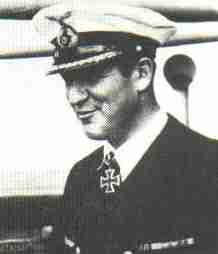
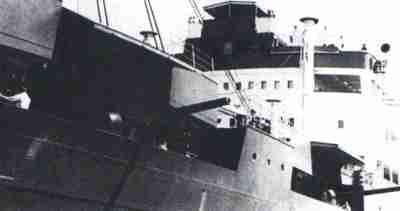
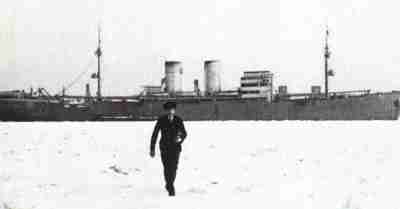
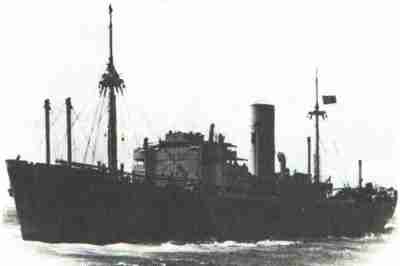

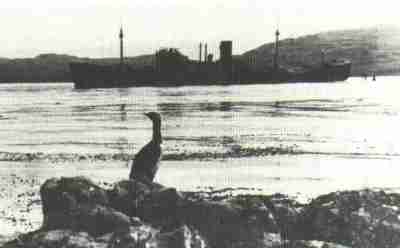
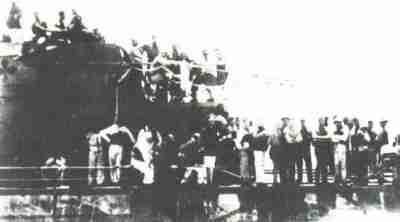
The raider KMS Atlantis, also known as Schiff (Ship) 16, was the first to prowl
the sea lanes. Atlantis was originally the freighter Goldenfels of
the Hansa Line and built in 1937 by Bremer Vulkan. Atlantis was hastily refitted
and commissioned in 1939 and assigned to captain Bernhard Rogge. The raider set out on
11 March 1940 to begin her 622-day long cruise, the longest of all raiders.
Taking on many disguises to resemble
neutral vessels, including the Soviet Kim, the Japanese Kasii Maru (which
was not successful even though some crewmen dressed as Japanese men and women), and
later the Dutch freighter Abbekerk, the Norwegian freighter Tamesis, etc.,
Atlantis sank her first victim, the British freighter Scientist, on 3
May 1940 in the South Atlantic. Then on the night of 10 May 1940 Atlantis laid her 92
mines off Cape Agulhas in South Africa. However, one mine exploded prematurely on 15
May and the Royal Navy promptly swept the minefield. Afterwards Rogge headed east into
the Indian Ocean to patrol the Durban-Australia track, with no success. Later Rogge
switched to the intersection of the Durban-Batavia and Mauritius-Australia routes, this
time with more success.
Atlantis spent the rest of 1940 in the Indian Ocean, where she captured or sank
her second to sixteenth victims. Rogge's crew put together half of the British
merchant code, and his pilot perfected the skill of tearing off the victim merchantman's
aerials with a trailing hook. The bored men on Atlantis befriended their captives,
sharing the same uncertain fate of the raider and usually the same meals. For example,
the Germans called the Chinese sailors Lung, Chan and Fong Krischman, Franz and Willi
respectively.
On the 13th victim, the British freighter Automedon, Rogge found some extremely
important papers including a British War Cabinet report outlining the empire's defense
system in the Far East. Rogge sent the documents to Japan, and, after the fall of
Singapore, received a samurai sword from Emperor Hirohito, thus becoming one of the three
Germans to do so (the other two being Herman G�ring and Erwin Rommel).
Atlantis and her men then stayed in the Kerguelen Islands in the Indian Ocean,
the raider grounded while nearing land, resulting in some nervous and tense moments.
Operation continued in January 1941. Atlantis netted more victims, but life on
board was tedious and routine. Crew morale was high nonetheless, except for a group of
Nazis, who, according to Rogge's adjutant Dr. Ulrich Mohr, inclined to show some
socialist characteristics.
Atlantis rendezvoused with some supply ships and an Italian submarine. On 8 April
she returned to the Atlantic, where she got her next five victims. On the night of 17/18
April, Atlantis' men got a bad scare when the British battleship Nelson
and carrier Eagle, unaware of the raider's presence, brushed by within 7,000
yards.
On 6 August 1941, Atlantis ventured into the Pacific Ocean, where she found only
one prize. The raider crossed the Pacific and Indian, and was supplying U-126 in
the Atlantic when she was jumped by the cruiser HMS Devonshire. Rogge was
outranged and did not fire a shot so the true identity of his ship would not be disclosed.
The survivors, including former captors and captives, were left stranded due to report
of a U-boat nearby. Later they were picked up by the German supply ship Python,
which was suck also when again supplying U-boats. The submarines rescued the survivors,
and were later joined by some Italian submarines. By 29 December 1941, all submarines
returned to St. Nazaire with Rogge and his men.
Back to German Auxiliary Cruisers Page
Back to Kriegsmarine Page
Back to Homepage